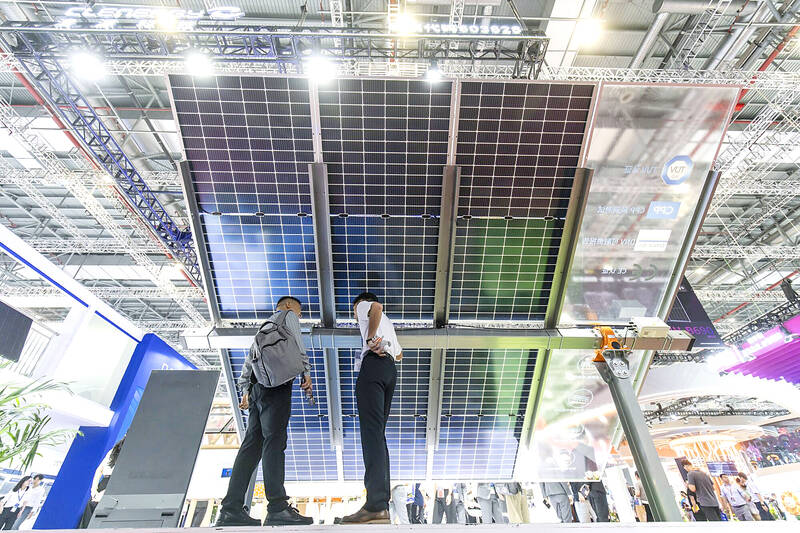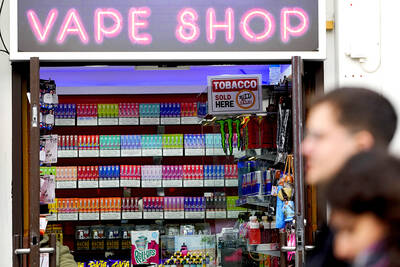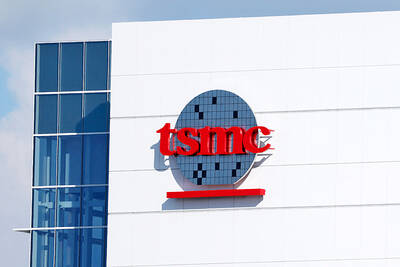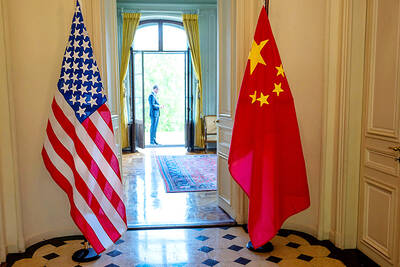Visitors to the world’s biggest showcase of solar power could be forgiven for not realizing just how dismal conditions are in China’s flagship clean energy industry.
Hundreds of thousands of people descended on Shanghai’s largest convention center last week for the city’s annual solar gathering, where a carnival mood prevailed. However, behind the scenes, executives were fretting over the crisis engulfing the sector.
In China, solar prices have collapsed after a breakneck expansion created far too much capacity, forcing many firms to sell at a loss. Abroad, China’s dominance of the world’s supply chains is being tested by an explosion in protectionism.

Photo: Bloomberg
“We’re entering into a deep down-cycle,” Amy Song (宋贇波), vice president at solar material maker GCL Technology Holdings Ltd (協鑫科技控股), said in an interview on Friday with Bloomberg TV.
“Barely anyone is making money right now,” Song added.
Solar’s rise over the past two decades has been meteoric. The industry has grown from a niche sector for environmentalists to the planet’s dominant source of new energy. The world added 445 gigawatts (GW) of solar panels last year, more than all other power sources combined in any year of human history. Most of them were made in China.
That has propelled the growth of multibillion dollar companies, which are now comparable to the giants of oil and gas. However, it has also created the conditions that have bedeviled commodities markets through the ages. China’s solar companies have boomed, and now they are heading for a bust that could eclipse earlier downturns in the industry’s fortunes.
The rapid build-out is a typical tragedy of the commons.
Companies looked out for their own interests without considering the overall impact if all their rivals acted the same way, said Gao Jifan (高紀凡), chairman of Trina Solar Co (天合光能), the world’s third-largest manufacturer of panels.
They were helped along by local governments eager to meet their growth targets and banks hungry to make loans, he said.
Gao was one of several executives who called last week on the Chinese government to intervene to help the industry get back on its feet. The menu of options presented included regulating which new factories can be built, cracking down on less-efficient facilities, capping price cuts and promoting consolidation.
In the meantime, too many factories are bidding to supply too few projects, which has driven down prices to record lows and industry executives have warned that bankruptcies are in the offing.
Solar’s biggest backer is Beijing. The industry is one of the Chinese government’s ‘new productive forces’ that it hopes would allow the Chinese economy to pivot from decades of growth driven by the property market, low-end manufacturing and state-led investment. Other clean energy sectors like batteries and electric vehicles are in the same stable.
Beijing’s support, which in years past included generous subsidies, has helped deliver a world-beating industry. Chinese companies control more than 80 percent of capacity along every step of the supply chain. That has rankled foreign governments, which do not want to rely on a geopolitical rival for energy, and crave some of the industry’s jobs for their own people.
US President Joe Biden last month toughened trade measures against solar equipment from China, and his administration is now targeting operations in Southeast Asia, which are viewed as fronts that have allowed Chinese firms to bypass tariffs. India has also imposed import duties, and there have been calls in Europe to follow suit.
However, the issues faced by the industry are technical as well as commercial.
China installed a record 217GW of panels last year — more than has ever been built in the US — and solar now accounts for 22 percent of the country’s total generating capacity. However, sunlight’s intermittency is straining the electricity grid.
Hundreds of small cities have halted approvals for new rooftop solar projects, and panels across the country are seeing their hours of usage reduced as the grid rejects their electricity because there is not enough space for it during daylight hours.
The broader solution is for grids around the world to build more power lines that can transfer excess clean power to where it is needed. More storage, mainly via batteries, is also required. However, adding those costs means solar power would need to keep getting cheaper.
For now, the industry is focused on belt-tightening. Longi Green Energy Technology Co (隆基綠能), once the world’s most valuable solar manufacturer, earlier this year announced that it would lay off thousands of workers. Others have halted production. Smaller producers are being forced to delist their shares from stock exchanges.
Wuxi Suntech Power Co (無錫尚德電力) chairman Wu Fei (武飛) likened China’s solar sector to the home appliance makers of 15 years ago, when 300 or so companies vied to sell washing machines, fridges and air-conditioners across the country. That industry has consolidated to just a handful of players and solar will likely follow suit, he said.
“Today’s photovoltaic reshuffle has just begun,” he said. “The second half of the year will be even worse.”

Real estate agent and property developer JSL Construction & Development Co (愛山林) led the average compensation rankings among companies listed on the Taiwan Stock Exchange (TWSE) last year, while contract chipmaker Taiwan Semiconductor Manufacturing Co (TSMC, 台積電) finished 14th. JSL Construction paid its employees total average compensation of NT$4.78 million (US$159,701), down 13.5 percent from a year earlier, but still ahead of the most profitable listed tech giants, including TSMC, TWSE data showed. Last year, the average compensation (which includes salary, overtime, bonuses and allowances) paid by TSMC rose 21.6 percent to reach about NT$3.33 million, lifting its ranking by 10 notches

Popular vape brands such as Geek Bar might get more expensive in the US — if you can find them at all. Shipments of vapes from China to the US ground to a near halt last month from a year ago, official data showed, hit by US President Donald Trump’s tariffs and a crackdown on unauthorized e-cigarettes in the world’s biggest market for smoking alternatives. That includes Geek Bar, a brand of flavored vapes that is not authorized to sell in the US, but which had been widely available due to porous import controls. One retailer, who asked not to be named, because

SEASONAL WEAKNESS: The combined revenue of the top 10 foundries fell 5.4%, but rush orders and China’s subsidies partially offset slowing demand Taiwan Semiconductor Manufacturing Co (TSMC, 台積電) further solidified its dominance in the global wafer foundry business in the first quarter of this year, remaining far ahead of its closest rival, Samsung Electronics Co, TrendForce Corp (集邦科技) said yesterday. TSMC posted US$25.52 billion in sales in the January-to-March period, down 5 percent from the previous quarter, but its market share rose from 67.1 percent the previous quarter to 67.6 percent, TrendForce said in a report. While smartphone-related wafer shipments declined in the first quarter due to seasonal factors, solid demand for artificial intelligence (AI) and high-performance computing (HPC) devices and urgent TV-related orders

MINERAL DIPLOMACY: The Chinese commerce ministry said it approved applications for the export of rare earths in a move that could help ease US-China trade tensions Chinese Vice Premier He Lifeng (何立峰) is today to meet a US delegation for talks in the UK, Beijing announced on Saturday amid a fragile truce in the trade dispute between the two powers. He is to visit the UK from yesterday to Friday at the invitation of the British government, the Chinese Ministry of Foreign Affairs said in a statement. He and US representatives are to cochair the first meeting of the US-China economic and trade consultation mechanism, it said. US President Donald Trump on Friday announced that a new round of trade talks with China would start in London beginning today,